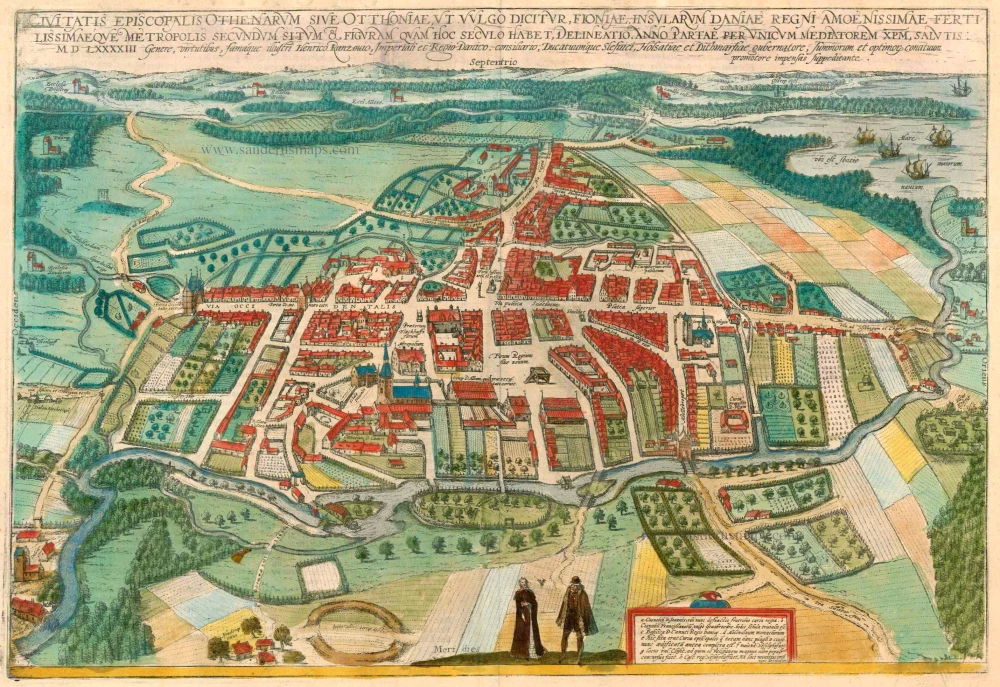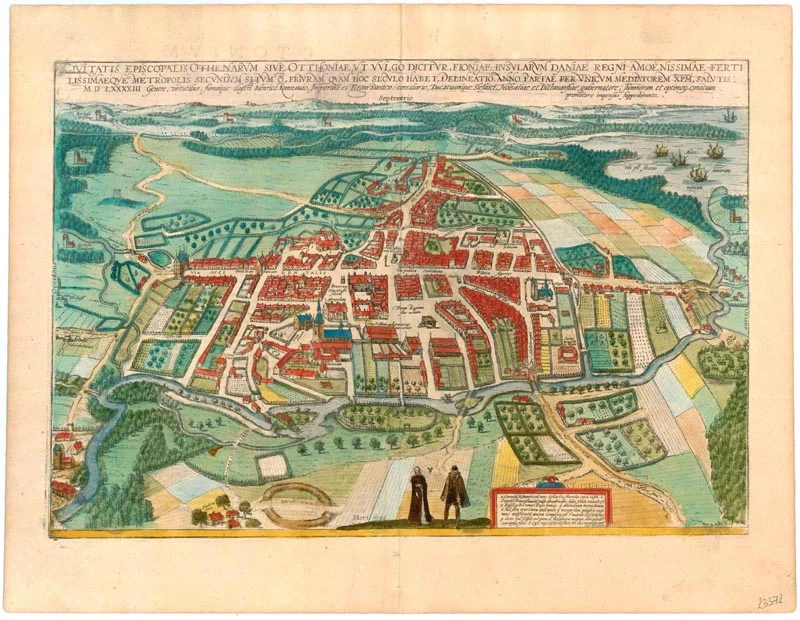Odense, by Georg Braun and Frans Hogenberg. 1596-1640
TRANSLATION OF CAPTION: The picture shows the present location and shape of the episcopal city of Othenarum or Odense in the vernacular, the capital of Funen, the loveliest and most fertile island in the Kingdom of Denmark. In the year of grace 1593. Heinrich Rantzau, known for his high birth, virtue and fame, counsellor to the Danish royal court, lord of the Duchies of Schleswig, Holstein and Dithmarschen and a patron of grand and splendid endeavours, bore the costs.
COMMENTARY BY BRAUN (on verso): "Odense is the capital of Funen, the loveliest and most fertile island in the Kingdom of Denmark. It is distinguished by magnificent buildings and splendid churches, of which the noblest is the basilica of the King of Denmark, St Canute. There is also a St John's monastery within the city, but since all the monks have died, it now houses the royal town hall. The city has a large, wide market in which tribunals are also held, and fish is sold."
The Danish city of Odense is presented in a sweeping panorama in a bird's-eye view from the south. The River Odense winding its way across the landscape, flows into the fjord in the top right-hand corner. It is noticeable that, in place of the ramparts present in most other cities, Odense is surrounded simply by a wooden fence. The city's numerous churches include, in the lower half of the picture on the left, the Sankt Knuds Kirke, or cathedral of St Canute, associated initially with a monastery and one of Denmark's largest and most important works of sacred architecture. In 1086, during a popular uprising, the Danish king Canute IV was murdered with several of his supporters in the wooden church that preceded the present building. Odense ("Odin's shrine") is mentioned for the first time in AD 988, in the Viking context of the cult of Odin. In the 11th century, it became an episcopal see, and in the mid-14th century was granted the rights of a trading city. Part of the royal court moved here c. 1500, stimulating growth both in the city and trade. Around 1600 the town had 6,000 inhabitants. (Taschen)
Braun G. & Hogenberg F. and the Civitates Orbis Terrarum.
The Civitates Orbis Terrarum, also known as the 'Braun & Hogenberg', is a six-volume town atlas and the most excellent book of town views and plans ever published: 363 engravings, sometimes beautifully coloured. It was one of the best-selling works in the last quarter of the 16th century. Georg Braun, a skilled writer, wrote the text accompanying the plans and views on the verso. Many plates were engraved after the original drawings of a professional artist, Joris Hoefnagel (1542-1600). The first volume was published in Latin in 1572 and the sixth in 1617. Frans Hogenberg, a talented engraver, created the tables for volumes I through IV, and Simon van den Neuwel made those for volumes V and VI. Other contributors were cartographers Daniel Freese and Heinrich Rantzau, who provided valuable geographical information. Works by Jacob van Deventer, Sebastian Münster, and Johannes Stumpf were also used as references. Translations appeared in German and French, making the atlas accessible to a broader audience.
Since its original publication of volume 1 in 1572, the Civitates Orbis Terrarum has left an indelible mark on the history of cartography. Seven more editions followed the first volume in 1575, 1577, 1582, 1588, 1593, 1599, and 1612. Vol.2, initially released in 1575, saw subsequent editions in 1597 and 1612. The subsequent volumes, each a treasure trove of historical insights, graced the world in 1581, 1588, 1593, 1599, and 1606. The German translation of the first volume, a testament to its widespread appeal, debuted in 1574, followed by the French edition in 1575.
Several printers were involved: Theodor Graminaeus, Heinrich von Aich, Gottfried von Kempen, Johannis Sinniger, Bertram Buchholtz, and Peter von Brachel, all of whom worked in Cologne.
Georg Braun (1541-1622)
Georg Braun, the author of the text accompanying the plans and views in the Civitates Orbis Terrarum, was born in Cologne in 1541. After his studies in Cologne, he entered the Jesuit Order as a novice, indicating his commitment to learning and intellectual pursuits. In 1561, he obtained his bachelor's degree; in 1562, he received his Magister Artium, further demonstrating his academic achievements. Although he left the Jesuit Order, he continued his studies in theology, gaining a licentiate in theology. His theological background likely influenced the content and tone of the text in the Civitates Orbis Terrarum, adding a unique perspective to the work.
Frans Hogenberg (1535-1590)
Frans Hogenberg was a Flemish and German painter, engraver, and mapmaker. He was born in Mechelen as the son of Nicolaas Hogenberg.
By the end of the 1560s, Frans Hogenberg was employed upon Abraham Ortelius's Theatrum Orbis Terrarum, published in 1570; he is named an engraver of numerous maps. In 1568, he was banned from Antwerp by the Duke of Alva and travelled to London, where he stayed a few years before emigrating to Cologne. He immediately embarked on his two most important works, the Civitates, published in 1572 and the Geschichtsblätter, which appeared in several series from 1569 until about 1587.
Thanks to large-scale projects like the Geschichtsblätter and the Civitates, Hogenberg's social circumstances improved with each passing year. He died as a wealthy man in Cologne in 1590.
Civitates Episcopalis Othenarum sive Otthoniae, ut vulgo Dicitur, Fioniae ...
Currently not available
Item Number: 23372 Authenticity Guarantee
Category: Antique maps > Europe > Northern Europe
Antique map - Bird'seye plan of Odense by Georg Braun and Frans Hogenberg.
Title: Civitates Episcopalis Othenarum sive Otthoniae, ut vulgo Dicitur, Fioniae ...
Date of the first edition: 1596.
Date of this map: 1596-1640.
Copper engraving, printed on paper.
Size (not including margins): 325 x 475mm (12.8 x 18.7 inches).
Verso: Latin text.
Condition: Excellent, superb old colour.
Condition Rating: A+.
From: Civitates Orbis Terrarum, ... Part 5. Köln, 1596-1640.
TRANSLATION OF CAPTION: The picture shows the present location and shape of the episcopal city of Othenarum or Odense in the vernacular, the capital of Funen, the loveliest and most fertile island in the Kingdom of Denmark. In the year of grace 1593. Heinrich Rantzau, known for his high birth, virtue and fame, counsellor to the Danish royal court, lord of the Duchies of Schleswig, Holstein and Dithmarschen and a patron of grand and splendid endeavours, bore the costs.
COMMENTARY BY BRAUN (on verso): "Odense is the capital of Funen, the loveliest and most fertile island in the Kingdom of Denmark. It is distinguished by magnificent buildings and splendid churches, of which the noblest is the basilica of the King of Denmark, St Canute. There is also a St John's monastery within the city, but since all the monks have died, it now houses the royal town hall. The city has a large, wide market in which tribunals are also held, and fish is sold."
The Danish city of Odense is presented in a sweeping panorama in a bird's-eye view from the south. The River Odense winding its way across the landscape, flows into the fjord in the top right-hand corner. It is noticeable that, in place of the ramparts present in most other cities, Odense is surrounded simply by a wooden fence. The city's numerous churches include, in the lower half of the picture on the left, the Sankt Knuds Kirke, or cathedral of St Canute, associated initially with a monastery and one of Denmark's largest and most important works of sacred architecture. In 1086, during a popular uprising, the Danish king Canute IV was murdered with several of his supporters in the wooden church that preceded the present building. Odense ("Odin's shrine") is mentioned for the first time in AD 988, in the Viking context of the cult of Odin. In the 11th century, it became an episcopal see, and in the mid-14th century was granted the rights of a trading city. Part of the royal court moved here c. 1500, stimulating growth both in the city and trade. Around 1600 the town had 6,000 inhabitants. (Taschen)
Braun G. & Hogenberg F. and the Civitates Orbis Terrarum.
The Civitates Orbis Terrarum, also known as the 'Braun & Hogenberg', is a six-volume town atlas and the most excellent book of town views and plans ever published: 363 engravings, sometimes beautifully coloured. It was one of the best-selling works in the last quarter of the 16th century. Georg Braun, a skilled writer, wrote the text accompanying the plans and views on the verso. Many plates were engraved after the original drawings of a professional artist, Joris Hoefnagel (1542-1600). The first volume was published in Latin in 1572 and the sixth in 1617. Frans Hogenberg, a talented engraver, created the tables for volumes I through IV, and Simon van den Neuwel made those for volumes V and VI. Other contributors were cartographers Daniel Freese and Heinrich Rantzau, who provided valuable geographical information. Works by Jacob van Deventer, Sebastian Münster, and Johannes Stumpf were also used as references. Translations appeared in German and French, making the atlas accessible to a broader audience.
Since its original publication of volume 1 in 1572, the Civitates Orbis Terrarum has left an indelible mark on the history of cartography. Seven more editions followed the first volume in 1575, 1577, 1582, 1588, 1593, 1599, and 1612. Vol.2, initially released in 1575, saw subsequent editions in 1597 and 1612. The subsequent volumes, each a treasure trove of historical insights, graced the world in 1581, 1588, 1593, 1599, and 1606. The German translation of the first volume, a testament to its widespread appeal, debuted in 1574, followed by the French edition in 1575.
Several printers were involved: Theodor Graminaeus, Heinrich von Aich, Gottfried von Kempen, Johannis Sinniger, Bertram Buchholtz, and Peter von Brachel, all of whom worked in Cologne.
Georg Braun (1541-1622)
Georg Braun, the author of the text accompanying the plans and views in the Civitates Orbis Terrarum, was born in Cologne in 1541. After his studies in Cologne, he entered the Jesuit Order as a novice, indicating his commitment to learning and intellectual pursuits. In 1561, he obtained his bachelor's degree; in 1562, he received his Magister Artium, further demonstrating his academic achievements. Although he left the Jesuit Order, he continued his studies in theology, gaining a licentiate in theology. His theological background likely influenced the content and tone of the text in the Civitates Orbis Terrarum, adding a unique perspective to the work.
Frans Hogenberg (1535-1590)
Frans Hogenberg was a Flemish and German painter, engraver, and mapmaker. He was born in Mechelen as the son of Nicolaas Hogenberg.
By the end of the 1560s, Frans Hogenberg was employed upon Abraham Ortelius's Theatrum Orbis Terrarum, published in 1570; he is named an engraver of numerous maps. In 1568, he was banned from Antwerp by the Duke of Alva and travelled to London, where he stayed a few years before emigrating to Cologne. He immediately embarked on his two most important works, the Civitates, published in 1572 and the Geschichtsblätter, which appeared in several series from 1569 until about 1587.
Thanks to large-scale projects like the Geschichtsblätter and the Civitates, Hogenberg's social circumstances improved with each passing year. He died as a wealthy man in Cologne in 1590.










